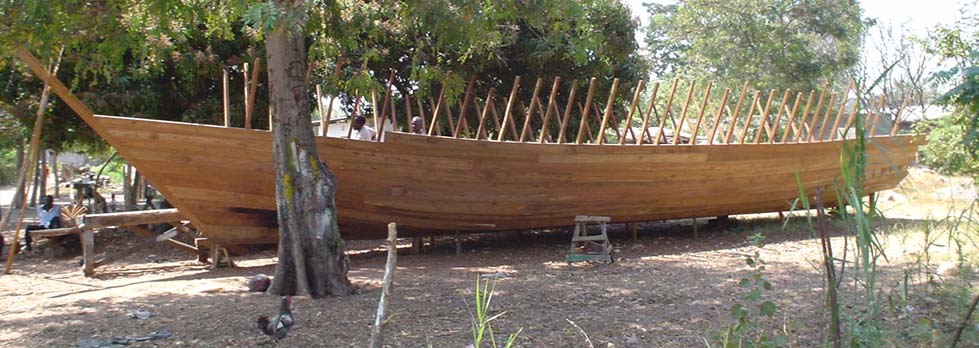
| Greetings Home |
| Previous Greeting |
| Next Greeting |
| Previous Dhow Logbook |
| Next Dhow Logbook |
Crtd 05-08-09 Lastedit 14-08-20
Diving Down the Line of Perfect Inertia
At Daniels dhow yard, there are now eight carpenters working
and I do not believe my eyes. It looks like they have run absolutely nuts:

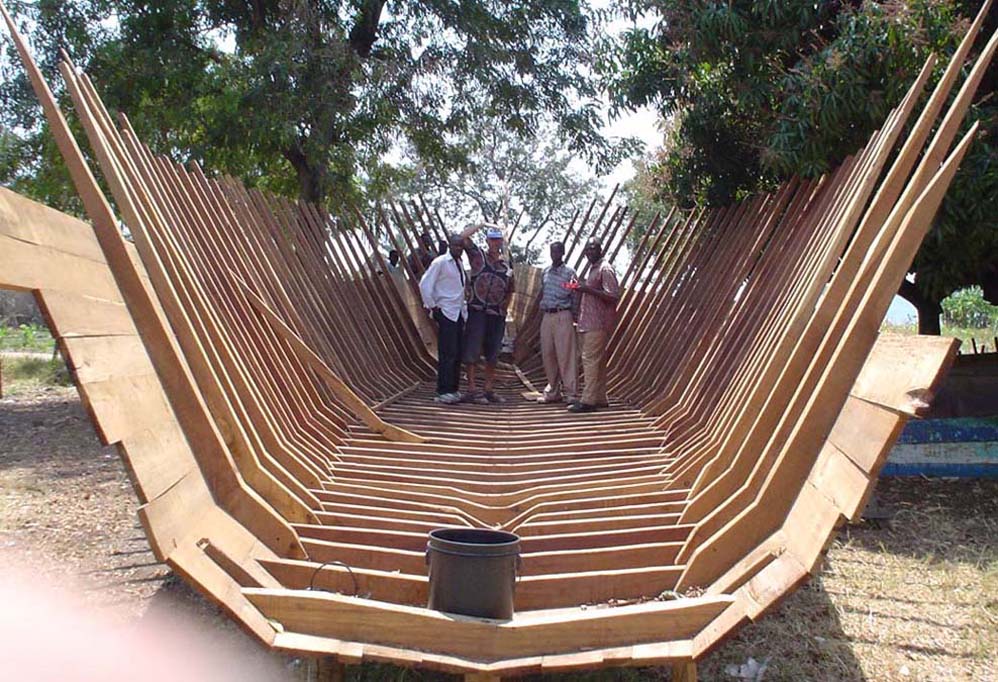
Photos: some days later... Photo down: Yard owner Daniel (right) now even takes lunch in my dhow
Soon we will paint the hull's outside and launch it in the
water. Moving to the shore (250m) without the weight of the decks is thought
expedient. I wanted Daniel to choose the color. He did not have to think long:
gley.
Grey? I realized that I had to take this and not ask for arguments. For a
while I was in revolt, but when I started thinking of mninga red-brown or
transparent varnish or better still, to cope smoothly with temperature
difference due to perpendicular sunrays, something like a linseed hardwood oil
for the deck, I really started to like grey for the boards.
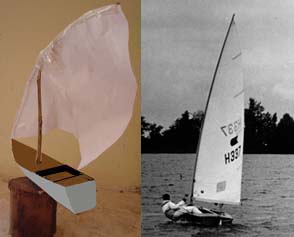
Photo: Left my original dhow model now
made "Daniel grey" with brown deck.
This was my first cardboard model of the dhow, made a
year ago.
I now realize its looks like the dinghy I had when I was 17 years old.
The sail in the model in the picture above is not unrealistically large in scale. It becomes impressive once you realize its size for an 18 m dhow measures at least over 100 m2, which certainly makes the single handed option require some tricks still to be found out. But we will!!
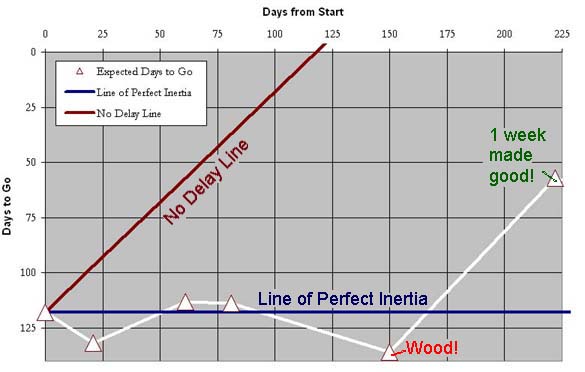
Graph: An African Dhow Yard On And Around The Line Of Perfect Inertia. Goto: Line Of Perfect Inertia Explained, next triangle
This is a most interesting graph. At day 0, the day of the agreement (the first triangle left down) the dhow yard bound itself to a date of delivery (120 days later, top of the brown No Delay Line). The idea of doing what you commit yourself to in the contract is following the brown line and deliver at day 120. But after some 25 days (the second triangle read upward to the horizontal-axis), the delay was some 30 days (read leftward to the vertical-axis). If only absolutely nothing is done, every day is a delay day. That is the blue line, which I call the line of perfect inertia. How to get below that line? On top of doing absolutely nothing some disturbing thoughts were formed that made the yard expect a longer building period. At the next two triangles, delay roughly equaled the passing of time: perfectly inert. At the triangle marked "wood!", the moment when the wood arrived on the yard, the expectations I was given were again well below the line of perfect inertia: roughly half a year delay in 150 days! But then there was wood. At 220 days after the contract there turned out to be no further expected delay, yes a week of delay was recovered, which brings us well above the line of perfect inertia. N.B. this is all about the expectations given to me, the job is not done, so let us stay sober: in Africa everything is possible, nothing is certain. The delivery is there when the last triangle touches the top axis of the graph, "zero days to go", or delivery.
Learning Kiswahili is now a race against the work at the dhow yard: when it comes to the deck I should be able to give clear day to day Kiswahili instructions. But my fresh versatility in Adobe Photoshop, forced upon me because I was unable to find my Paint Shop Pro in Uganda, is even more important: drawings on scale, with many layers, so you can switch the different aspects on and off: decks, interior, hatches, cabins, etc. Jeremia insists on working metric, Daniel works in inches and feet, or simply by closing one eye and looking along whatever part he is making. Hence we end up looking at the boat and at these drawings without caring very much about the exact measures. We talk about "motorcycle", "standing", "creeping", "outboard" instead of centimeters. At critical moments I mark heights and widths on the wood of the boat. Every day I tell them: keep that main compartment front to back higher than 2 meters or I will have backaches the rest of my life! This got through: there is a stick of exactly my length on the yard.

Picture: Dhow design after-the-fact. And
still wrong! After marking the toilet on the yard according to this drawing I had,
on port, only space left for one
cabin instead of the two envisaged.
I deleted these beautiful rasterized pictures and started to count
frames.
No two frames have an equal distance though.
Nevertheless, all spare time frantically goes into Kiswahili. I do my Kiswahili at hotel Tilapia, where the staff and Tanzanian visitors not only answer my questions "Unamuhitaje...kwa kiswahili" (How do you say...in Kiswahili), but gladly offer to check my school book exercises and add useful language information. Some of them now even refuse, for pedagogical purposes, to talk English with me.
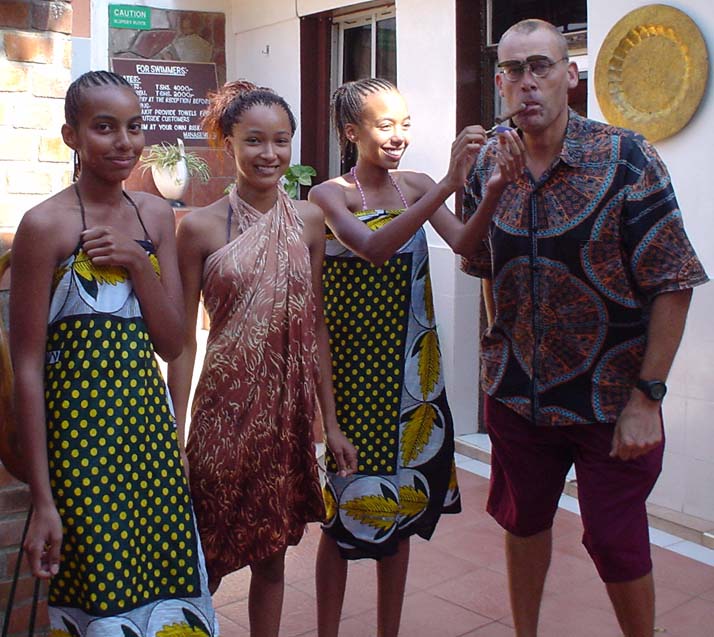
Some Tilapia Swimming Pool Attendants
These ladies (picture above) I find in the
hotel's swimming pool. They are absolutely flawlessly speaking my own local
language, Dutch. Theirs is the latest modern pronunciation, one that left me behind. I call it
"Veronica-Dutch": the Veronica TV
channel quite successfully introduced a new accent in which "r" is pronounced in some occasions as a
vocal guttural "g" and on all other occasions as a mute "i".
Patricia, Gaby and Irene moved from Mwanza with their parents at resp. 4, 3
and 5 years old to resp. Helmond, Eindhoven and Rotterdam, The Netherlands,
with their Dutch fathers and Tanzanian mothers. Now at Dutch
high schools, they are visiting Tanzania together because their mothers are
friends. They say they are not yet so satisfied with their Kiswahili but they are
working on it.
My favourite Kiswahili teacher among the Tilapia staff is Godberta. Not only does
she immediately understand my questions, but when I show I learned something by
giving another example I am praised extensively, which of course boosts my
energy to go on, hunting for further compliments. Meanwhile she makes my cappucino's ("cappuccino nyingine tafadhali - another cappuccino please").
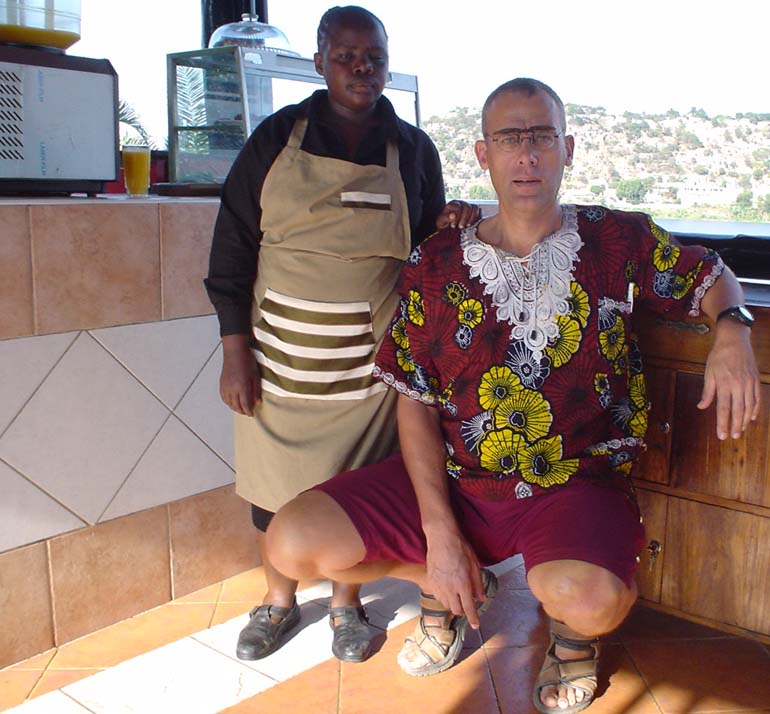
Photo: Godberta
Needless to say, at night I dream of life on the dhow with Godberta and the three Dutch half-goddesses, but the next morning I wake up sure again: We shall do our own cappuccino's, this is going to be a single handed affair !
| Greetings Home |
| Previous Greeting |
| Next Greeting |
| Previous Dhow Logbook |
| Next Dhow Logbook |